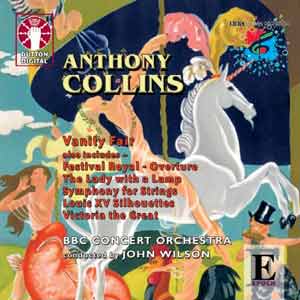Film and Other Music by Anthony Collins
Music composed by Anthony Collins
Performed by BBC Concert Orchestra
Conducted by John Wilson
Available on Dutton (CDLX 7162)
Running Time: 73:52
Amazon UK
Featuring:
Victoria the Great (1937) [13:12]
The Lady With a Lamp (1951) [4:53]
Valse Lente, from Odette (1950) [2:18]
Vanity Fair (1952) [3:42]
Festival Royal Overture (1956) [4:30]
Eira (1938) [11:04]
Santa Cecilia (1959) [4:14]
Louis XV Variations (1939) [11:45]
Symphony for Strings No. 1 (1940) [12:12]
The Song of Erin (Lamentation) [5:05]

See also:
Anthony Collins Sibelius Cycle Anthony Collins is probably best remembered today as a gifted conductor of classical music, particularly of Sibelius and especially of that composer’s symphonies, all seven of which he memorably recorded for Decca in the early days of LPs (early 1950s). Collins wrote many film scores, notably for producer Herbert Wilcox in England. Collins settled in Hollywood and wrote music for RKO Radio Pictures. His film scores (other than those featured here) include The Swiss Family Robinson and Tom Brown’s Schooldays. Alas much of his music seems to have gone missing due to various takeovers in the music-publishing industry. But with this new release, piloted by the young conductor John Wilson (also something of a scholar specialising in lighter music), perhaps a Collins’s revival might be imminent?
Victoria the Great, starring Anna Neagle, was Anthony Collins’s first film score. The ‘Prelude’ opens and closes imposingly, as befits the subject, with one of Collins’s memorable ‘royal’ slow marches not far removed from Elgar and Walton and used in the coronation scenes. In between there is atmospheric material underscoring the Lord Chamberlain’s urgent ride to Kensington to inform the young Victoria that she is now Queen. ‘Portrait of Lord Melbourne on his Horse’ introduces some gentle whimsy in the eighteenth century classical tradition as the old soldier is mildly ribbed by the Queen while having his portrait painted. ‘Victoria and Albert’ is a tender picture of domestic conjugal bliss while ‘The Queen’s Caprice’ underscores Victoria’s gentle guying of the hesitant Prince Albert when they first meet. The end titles feature ‘Victoria Regina’, another grand march complete with cannon salutes and integrated with the coronation music. It concludes this suite.
From another Anna Neagle film about the World War II heroine, Odette, we hear the charming Viennese-waltz-style ‘Valse Lente’. The Lady with Lamp, again featuring producer Herbert Wilcox’s wife, Anna Neagle, is represented by ‘Prelude and Valse Variations’. Collins’s Prelude music speaks eloquently of suffering, endurance and heroism while the waltz variations move from battlefields to glittering ballrooms.
The Festival Royal Overture forms a wonderful rousing opening to this album’s concert. As its name implies, it is full of pomp and circumstance. It was first performed by the BBC Concert Orchestra on June 6 1956, conducted by Stanford Robinson. Besides its royal connotations it would seem to be very suitable for newsreel introductory music.
Perhaps the best-known item is Collins’s delightful four minute light music encore, Vanity Fair first broadcast September 1952 and has been performed countless times since. The Song of Erin (subtitled Lamentation [perhaps for a dead hero as the concluding bars might suggest] is a mistily atmospheric Celtic piece spotlighting the cor anglais. Also from the Emerald Isle, Eire is a 3-movement suite commencing with a jolly swaggering ‘Battle March’ setting of ‘Mat Hannigan’s Aunt’. Next comes a misty dream-like ‘Reverie’ arrangement of the well-known song ‘The Mountains of Mourne’ and finally another merry setting of ‘Phil the Fluter’s Ball’. Saint Cecilia, termed by Collins as a madrigal, was one of the composer’s last compositions, written some four years before his death. No clue is given to the subject matter of this gently flowing work except that it might be thought to be a sunny depiction of the church of that name in Rome.
Louis XV Silhouettes’ first movement ‘At Versailles’ begins majestically with a flourish in the grand style of Lully before proceeding to sound rather more like Handel. ‘At the Tuileries’ covers various dances: ‘Sicilienne’, ‘Tambourin’, ‘Pavane’, ‘Forlane’, and ‘Passecaille’ - all cast in the style of the period but with an unmistakeable Collins overlay, often spiced with a pinch of sly wit. The Suite concludes with a movement entitled ‘At Luciennes’ located at the chateau of the King’s mistress Madame du Barry. The music is all feminine charm, frippery and inconsequence.
The album concludes with Collins’s Symphony for Strings, another example of the composer’s predilection for pastiche period pieces. And once more his style is elastic, overlaying his own light, witty touch over: first a Haydn-like Allegro; then an introspective ‘Adagio molto’ that mourns gravely in the style of Bach, and finally the ‘Allegro vivace’ that takes us back to the Celtish with a jolly, skittish setting of a song that I seem to remember is entitled ‘Oh Dear What Can the Matter Be?’ or has that line predominant.
John Wilson leads the BBC Concert Orchestra in sparkling performances of these charming confections.
Film, and other music, by a quite-forgotten composer-conductor. ’Charming light music, worth exploring by the adventurous. The variety of the material makes it difficult to rate, so it’s with some qualification I give this the rating I do.
Ian Lace
Rating:
4
Return to Reviews Index